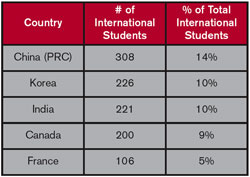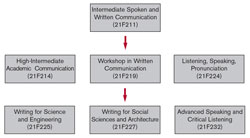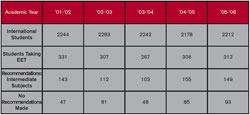
| Vol.
XIX No.
1 September / October 2006 |
| contents |
| Printable Version |
Teach Talk
Supporting MIT's International Graduate Students: Communicating Within and Across Cultures
In her piece in the March/April issue of the Faculty Newsletter, Danielle Guichard-Ashbrook provides an overview of the impact of Homeland Security’s SEVIS system on international student applications and visas to attend MIT. She touched on two central pillars of our culture. First, international graduate students are valued partners in our mission to work with educators and researchers across national boundaries to address the world’s major challenges. Second, MIT is committed to providing an excellent educational and research environment here in Cambridge for all members of its diverse student community.
Another defining feature of MIT’s culture is the assumption that all graduate students will contribute to MIT’s intellectual and creative environment in a variety of ways, such as challenging the status quo, collaborating in research, publishing, interacting in seminars, and teaching undergraduates. Adequate English communication skills are essential for engaging in these activities at MIT and beyond.

Table 1. Countries with the largest student representation at MIT (2005-2006).
(Source: Office of the Provost, 2006)
MIT currently has 2212 international students enrolled. Table 1 provides the number of students from the five countries with the largest representation. This information encapsulates the range in English proficiency of our international student population. Many speak English as a second (or additional) language (e.g., Chinese, Korean, and French students); a substantial number are functionally bilingual or native speakers, like those from India and Canada.
Regardless of mother tongue, many international graduate students engage assertively and successfully in the communication culture here starting in their first semester.
Others, however, struggle to understand and participate effectively in MIT’s intellectual environment. A variety of linguistic and cultural factors can determine whether someone is an effective communicator, in general, and whether students can adjust easily to MIT’s communication culture:
- Native language
- Pedagogical and communication cultures of home countries
- Prior exposure to English spoken and written by native English speakers
- Personality and talents
- Motivation and interest
- Communication environment in MIT dorms, lab groups, and departments
| Back to top |
How do we help international graduate students participate in the communication culture here?
There’s no question that MIT’s entering international graduate students are expert learners who have studied hard to meet the requirements of admission. But they, and their advisors, are frequently unaware that the English test-taking skills that allowed them to succeed in the TOEFL test and the GRE may be inadequate for the flexible, interactive production of English required in this lively educational and research community.
The first step is to ensure, in a timely manner, that students who need help know that they need help. The English Evaluation Test (EET), administered each semester by the English Language Studies (ELS) group in the Foreign Languages & Literatures section of the Humanities Department, provides each student and advisor with an assessment of the student’s English skills.
The EET
Since 1984, the Committee on Graduate Student Programs (CGSP) has required all entering international graduate students whose primary language of instruction from the age of six through high school has not been English to take the EET. The EET focuses on academic English and is composed of three parts that measure comprehension and production: a multiple-choice assessment of listening and reading comprehension, as well as accuracy in sentence structure; a writing task; and an interview. The test identifies weaknesses in discrete areas of English that may contribute to problems with some aspects of a student’s course work, teaching, or research.
Students do not “pass” or “fail” the EET. Rather, the assessment provides them and their advisors with predictive information to inform subject choices on Registration Day and decisions about teaching and research assistantships. (See EET FAQs at web.mit.edu/fll/www/languages/EETFAQ.shtml for more details.)
Course Offerings in the English Language
Studies Program (ELS)
Our English language subjects are designed for the intermediate through advanced or functionally bilingual English speakers that form a substantial part of MIT’s multicultural student body. The major goal of the program is to foster accuracy, facility, appropriateness, and confidence in a variety of academic and professional contexts. Any student earning a degree at MIT can register for one of the subjects listed in Figure 1. These are regular grade- and credit-bearing classes that meet according to the MIT academic calendar.

(click on image to enlarge)
All subjects are designed to provide a great deal of practice and feedback in targeted skill areas. Students are not expected to achieve native accuracy or fluency; nor are they expected to “sound like Americans.” Those goals would be entirely unrealistic. Instead, we focus on strengthening or modifying the aspects of students’ English – for example, listening comprehension or pronunciation – that prevent easy communication. For some students, one ELS course will be insufficient.
Generally, one course cannot be easily substituted for another. For example, Intermediate Spoken & Written Communication (21F211) is recommended for students whose EET results indicate that their academic English skills are inadequate in all categories. Few entering MIT graduate students fall into this category, but those who do truly need to improve all skills as soon as possible! None of the other ELS subjects covers the same intermediate level material.

(click on image to enlarge)
Table 2 indicates the patterns of eligible international graduate students who have taken the EET over the past five years. Note that, in the last two years, the English skills of almost 1/3 of these students have been assessed as adequate for understanding lectures; teaching recitations or labs; holding office hours, interacting effectively in research groups; delivering oral presentations; and writing memos, research papers, reports and thesis. Therefore no recommendations were made. A performance level of “Adequate” does not imply that these students will be excellent as recitation or lab instructors, presenters of research or writers of grant proposals. Few graduate students from any countries, including the U.S., have studied best practices in pedagogy, academic speaking, or writing.
Most recommendations resulting from the EET are made for the three high-intermediate subjects in the middle tier. A student receiving a recommendation for any of these subjects is likely to have enough difficulty understanding or contributing to essential communications that action is required as soon as possible. Students acting on these recommendations often start with High-Intermediate Academic Communication (21F214), which is designed to develop accuracy and flexibility in all English skills. Some students continue with English studies in subsequent semesters, narrowing their focus to either writing or speaking/listening comprehension at the high-intermediate level before moving on to the advanced subjects.
| Back to top |
Writing Tasks Important for Graduate Academic Success
The curriculum for writing instruction and practice throughout the three levels in the ELS program is designed to develop and strengthen those skills identified as most important in an extensive survey of American professors. (Source: M. Rosenfeld, R. Courtney, and M. Fowles. Identifying the Writing Tasks Important for Academic Success at the Undergraduate and Graduate Levels. GRE Board Report No. 00-04R.) Students should be able to:
- Credit sources appropriately
- Analyze and synthesize information from multiple sources
- Organize ideas and information coherently
- Develop a well-focused, well-supported discussion, using relevant reasons and examples
- Use grammar and syntax that follow the rules of standard written English
- Write clearly, with smooth transitions
- Avoid errors in mechanics
- Write precisely and concisely
- Abstract or summarize essential information
- Revise and edit text to improve its clarity, coherence, and correctness
The Advanced ELS Workshops
The advanced ELS workshops (21F225, 21F227, and 21F232) are best suited to students who are managing relatively well in MIT’s communication culture, but who wish to fine-tune accuracy in writing or listening and speaking; build more fluency; and develop confidence. These subjects are most helpful to students who are already engaged in research activities at MIT, i.e., students who have been at MIT for at least two semesters and have finished much of their coursework. Interestingly, the advanced subjects regularly attract bilingual students who seek instruction, practice, and feedback in academic speaking and writing, even in the absence of EET recommendations. In fact, the relative scarcity of graduate subjects in academic and professional communication Institute wide has occasionally resulted in American students asking permission to register in one of these advanced ELS workshops.
The writing workshops provide motivating contexts in which students learn and practice strategies for audience analysis, document design, and tone. They can write about their own work in various conventional forms such as memos, proposals, journal articles, research reports, and theses.
The Advanced Speaking & Critical Listening Skills workshop (21F232) focuses on effective communication in meetings, seminars, classrooms, poster sessions, conferences, and corporate contexts. Many activities in class are recorded onto DVDs, allowing easy, frequent, and timely analysis and feedback. A major component of 21F232 is the study and practice of the interactive teaching and mentoring expected of a recitation TA. As part of the workshop, the course instructor visits the recitations of students in 21F232 who are currently TAs, records their teaching, and meets with them to discuss the recorded session.
Another option for students interested in working on their teaching skills is a three-unit Workshop in Strategies for Effective Teaching (21F230), offered each IAP. It provides most of the instruction, materials, and practice that are covered in the teaching unit of 21F232.
Other possibilities for academic English language study at MIT
Aside from taking formal subjects in the ELS Program, MIT provides two other ways to study academic English. First, the Language Learning & Resource Center (LLARC) in Building 16-644 offers free access to an excellent collection of materials for self-study, from low-tech options (textbooks, cassettes, and videos) to interactive DVDs and computer programs. (The Center’s catalogue and schedule are available at llarc.mit.edu/home.) In addition, the Writing & Communication Center in Building 32-081 offers free, individual consultations on any kind of speaking or writing task at any stage in its development. Tutors there do not edit students’ documents; they work with students to strategize, analyze, and improve them. They are also available to help students
plan and deliver presentations. Any member of the community, including family members, may take advantage of the material and expertise available in these two centers.
MIT’s goals are ambitious, and the world’s challenges are, indeed, great. To succeed, we need to tap the intellectual rigor and creativity of every one of us. Confidence and facility in English, as well as familiarity with academic communication norms, will go a long way toward enabling all of our international graduate students to contribute fully as members of our Cambridge community and as partners in our international mission.
| Back to top | |
| Send your comments |
| home this issue archives editorial board contact us faculty website |